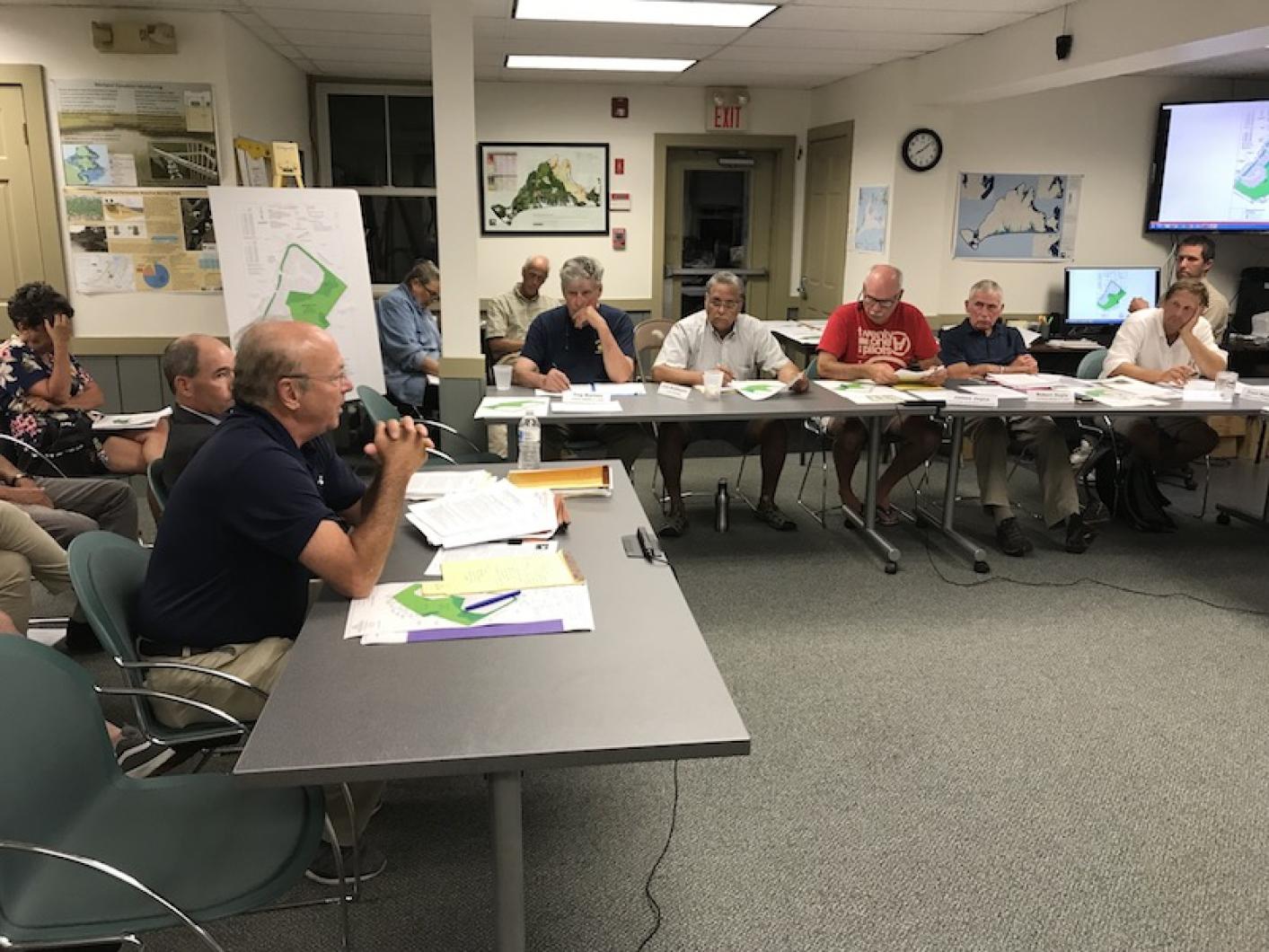Even with a significantly redesigned plan, the public turned out in force again to oppose a 29-lot subdivision off Meeting House Way in Edgartown at a packed public hearing Thursday night.
Opponents sounded a similar refrain as they have since the project came before the Martha’s Vineyard Commission earlier this winter, expressing concerns about growth and development on the Island.
“We’ve been furiously building up the Island for the last 50 years,” Jim Athearn, owner of Morning Glory Farm in Edgartown told the commission. “So when do we stop?”
A public hearing first opened in January on the plan for a 34-lot subdivision on a 54-acre parcel of land tucked between Meeting House and Meshacket Roads.
The developers are Douglas K. Anderson and Richard G. Matthews. The first plan had proposed parcels ranging between one and 2.6 acres with a maximum home size of 6,300 square feet and seven bedrooms. The homes would have been arranged in three clusters, with entrances off Division and Meshacket Roads.
But after vocal opponents packed public hearings this winter, the commission took the rare step of holding a mid-public hearing land use planning meeting to discuss the feasibility of the plan. The applicant agreed to go back to the drawing board amid concerns about affordable housing contributions, nitrogen, traffic and the use of open space.
“Literally outside in the parking lot the two applicants talked about it, and we said this is something that really needs more work,” project engineer Doug Hoehn told the commission Thursday, sitting alongside attorney Sean Murphy. “So we discussed parameters about what could be changed. They said, you guys redesign this. It’s more our plan than theirs now . . . we came up with basically what you see.”
The new plan has 29 lots ranging from half to three-quarter-acre acre parcels, 28 of them for market rate housing. The last lot would be divided into 10 townhouses for first-time homebuyers or “empty nesters.” The townhouses would cost $579,000 and only be available to qualified buyers who have spent either five years (for first-time homebuyers) or 15 years (for empty nesters) on the Island. The new plan includes more contiguous open space and almost entirely protects habitat for the rare imperial moth on the eastern side of the property.
Although the subdivision would be connected to town sewer, road clearing for construction would put the plan over the commission’s nitrogen loading limit for an impaired watershed (Edgartown Great Pond). The applicants have proposed connecting 12 homes on neighboring Hotchkiss Lane to the town sewer as remediation.
The developers are also offering a $1.1 million affordable housing contribution, about $500,000 of which will be paid to the Edgartown affordable housing committee upon receipt of all the permits. Another $22,000 would be paid for every lot sold and a one per cent transaction fee for future sales would go to the Dukes County Affordable Housing Committee.
In testimony Thursday, half a dozen Islanders expressed issues with the development despite the changes.
“I appreciate all the effort they have made to meet all the commission’s recommendations,” said Jeff Agnoli. “But clearly this is a pig’s ear that is not going to turn into a silk purse . . . This should be conservation land. It connects with other conservation land and goes all the way into the heart of Edgartown.”
Mr. Agnoli, a retired high school English teacher, urged the commission to reject the project despite the substantial affordable housing contribution.
“The detriments of this project to the environment, to the community, to the future, dwarf the benefits to a few people who already have homes,” Mr. Agnoli said. “You have a once-in-a-generation chance with this particular project to make a stand for this Island.”
Others questioned how covenants in the leases, such as a requirement to use solar arrays, build Energy Star 3.1-rated homes, and a 25-year deed restriction for the townhouses that prevent rentals or resale, would be enforced. Still others expressed fears about increased traffic from the development. The applicants plan to pave Division Road, a small connector that would serve as the subdivision’s three entry and exit points.
“What you will be allowing is the suburbanization of Martha’s Vineyard, particularly of Edgartown,” said Saul Greenfield. “It’s very unpleasant here to be on the road . . . I have more luck finding a parking spot in Manhattan than Edgartown.”
Emily Reddington, a biologist and executive director of the Great Pond Foundation, expressed concerns about the town’s threatened watershed. She said the pond has experienced algal blooms over the past two years after a decade of improving health.
“We’re already at the tipping point for this pond,” Ms. Reddington said. “Not only are we concerned about development in the watershed but we need to reduce what’s already there.”
Mr. Murphy and Mr. Hoehn answered questions from commissioners and the public. They emphasized green energy, how the nitrogen plan would be within the commission’s limit if they put the Hotchkiss Lane homes on town sewer, and talked about how the applicant’s affordable housing contribution is significantly higher than the commission’s recommended number.
After public testimony, a few commissioners expressed their own quandaries with the project. Commissioner Josh Goldstein asked if the land bank was interested in buying any part of the deed-restricted property. Mr. Murphy replied that the applicant had reached out, but that the land bank had no expressed interest.
“I don’t know how to balance the developers right to build something versus my high school English teacher’s opinion,” Mr. Goldstein said, referring to Mr. Agnoli’s testimony.
The hearing was closed. Deliberations and a vote are set for mid-September.







Comments (31)
Comments
Comment policy »